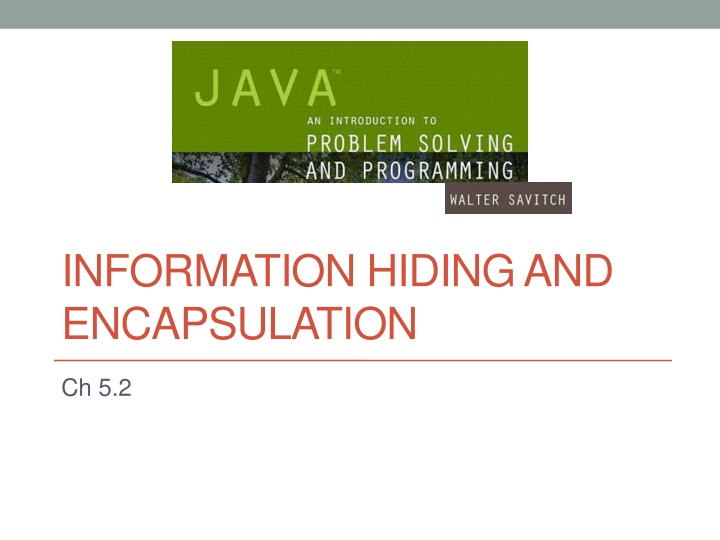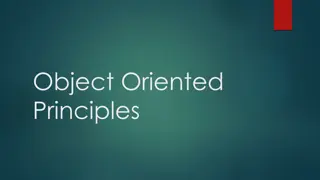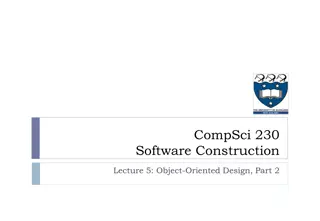
Information Hiding and Encapsulation
Explore the concepts of information hiding and encapsulation in Java programming through examples and explanations. Learn how these principles help in designing classes and methods to enhance code readability and maintainability.
Download Presentation

Please find below an Image/Link to download the presentation.
The content on the website is provided AS IS for your information and personal use only. It may not be sold, licensed, or shared on other websites without obtaining consent from the author. If you encounter any issues during the download, it is possible that the publisher has removed the file from their server.
You are allowed to download the files provided on this website for personal or commercial use, subject to the condition that they are used lawfully. All files are the property of their respective owners.
The content on the website is provided AS IS for your information and personal use only. It may not be sold, licensed, or shared on other websites without obtaining consent from the author.
E N D
Presentation Transcript
INFORMATION HIDING AND ENCAPSULATION Ch 5.2
2 CSC111 Adapted from: "JAVA: An Introduction to Problem Solving & Programming", 8th Ed. Information Hiding, Encapsulation: Outline Information Hiding The public and private Modifiers Methods Calling Methods Encapsulation UML Class Diagrams
3 CSC111 Adapted from: "JAVA: An Introduction to Problem Solving & Programming", 8th Ed. Information Hiding Client using a class method need not know details of the implementation of the method Only needs to know what the method does Information hiding: Designing a method so it can be used without knowing details Also referred to as abstraction Careful documentation of what a method does can achieve that. For more info read: pre/post conditions Method design should separate what from how
6 CSC111 Adapted from: "JAVA: An Introduction to Problem Solving & Programming", 8th Ed. The public and private Modifiers When an identifier is specified as public: Any other class can directly access that identifier by name When an identifier is specified as private: Only the class itself can directly access that identifier by name It can not be accessed directly from the outside Classes are generally specified as public Instance variables are usually private If no modifier is specified, the default is public
7 CSC111 Adapted from: "JAVA: An Introduction to Problem Solving & Programming", 8th Ed. public vs private in Species...Try public class SpeciesSecondTry { public String name; public int population; public double growthRate; public class SpeciesThirdTry { private String name; private int population; private double growthRate; public void readInput () { .... name = keyb.nextLine (); ... population=keyb.nextInt (); growthRate=keyb.nextDouble(); } public void writeOutput () { ... } public void readInput () { .... name = keyb.nextLine (); ... population=keyb.nextInt (); growthRate=keyb.nextDouble(); } public void writeOutput () { ... } public int predictPopulation (int years) { ... } } public int predictPopulation (int years) { ... } }
8 CSC111 Adapted from: "JAVA: An Introduction to Problem Solving & Programming", 8th Ed. public class SpeciesSecondTryDemo { public static void main (String [] args) { SpeciesSecondTry spOfTheMonth = new SpeciesSecondTry (); System.out.println ("Enter data ...:"); spOfTheMonth.readInput (); spOfTheMonth.writeOutput (); int futurePop = spOfTheMonth.predictPopulation(10); System.out.println("In ten years we have "+ futurePop); What if we use the update class we wrote? SpeciesThirdTry spOfTheMonth.name = "Klingon ox"; spOfTheMonth.population = 10; spOfTheMonth.growthRate = 15; These are valid as we saw before. Because the attributes are public System.out.println ("The new Species of the Month:"); spOfTheMonth.writeOutput (); System.out.println ("In ten years we have " + spOfTheMonth.predictPopulation(10)); } }
9 CSC111 Adapted from: "JAVA: An Introduction to Problem Solving & Programming", 8th Ed. public class SpeciesThirdTryDemo { public static void main (String [] args) { SpeciesThirdTry spOfTheMonth = new SpeciesThirdTry (); System.out.println ("Enter data ...:"); spOfTheMonth.readInput (); spOfTheMonth.writeOutput (); int futurePop = spOfTheMonth.predictPopulation(10); System.out.println("In ten years we have "+ futurePop); What about these methods? spOfTheMonth.name = "Klingon ox"; spOfTheMonth.population = 10; spOfTheMonth.growthRate = 15; These are now invalid because the attributes are private and we are outside the class of the object System.out.println ("The new Species of the Month:"); spOfTheMonth.writeOutput (); System.out.println ("In ten years we have " + spOfTheMonth.predictPopulation(10)); } }
10 CSC111 Adapted from: "JAVA: An Introduction to Problem Solving & Programming", 8th Ed. Programming Example Could be used like this in main: Rectangle box = new Rectangle(); box.setDimensions(10,5); System.out.println(box.getArea()); public class Rectangle { public int width; public int height; private int area; public void setDimensions (int newWidth, int newHeight) { width = newWidth; height = newHeight; area = width * height; } A statement such as box.width = 6; is legal since width ispublic Is it a good idea? Why? public int getArea () { return area; } No, it causes an inconsistency. Area would still be 50. }
11 CSC111 Adapted from: "JAVA: An Introduction to Problem Solving & Programming", 8th Ed. Programming Example Could be used like this in main: Rectangle box = new Rectangle(); box.setDimensions(10,5); System.out.println(box.getArea()); public class Rectangle { private int width; private int height; private int area; public void setDimensions (int newWidth, int newHeight) { width = newWidth; height = newHeight; area = width * height; } A statement such as box.width = 6; is illegal since width isprivate Is it a good idea? Why? public int getArea () { return area; } Yes, keeps remaining elements of the class consistent Can we improve it more? }
12 CSC111 Adapted from: "JAVA: An Introduction to Problem Solving & Programming", 8th Ed. Programming Example Could be used like this in main: Rectangle box = new Rectangle(); box.setDimensions(10,5); System.out.println(box.getArea()); public class Rectangle2 { private int width; private int height; private int area; public void setDimensions (int newWidth, int newHeight) { width = newWidth; height = newHeight; area = width * height; } A statement such as box.width = 6; is illegal since width isprivate And now we are NOT storing area but computing it when needed. public int getArea () { return width * height; } }
13 CSC111 Adapted from: "JAVA: An Introduction to Problem Solving & Programming", 8th Ed. Accessor and Mutator Methods When instance variables are private must provide methods to access values stored there Typically named getSomeValue Referred to as an accessor method Must also provide methods to change the values of the private instance variable Typically named setSomeValue Referred to as a mutator method
14 CSC111 Adapted from: "JAVA: An Introduction to Problem Solving & Programming", 8th Ed. Accessor and Mutator Methods Consider an example class with accessor and mutator methods View sample code, listing 5.11 class SpeciesFourthTry Note the mutator method setSpecies Note accessor methods getName, getPopulation, getGrowthRate
15 CSC111 Adapted from: "JAVA: An Introduction to Problem Solving & Programming", 8th Ed. Accessor and Mutator Methods Using a mutator method View sample program, listing 5.12 classSpeciesFourthTryDemo Sample screen output
16 CSC111 Adapted from: "JAVA: An Introduction to Problem Solving & Programming", 8th Ed. Programming Example A Purchase class View sample code, listing 5.13 class Purchase Note use of private instance variables Note also how mutator methods check for invalid values View demo program, listing 5.14 class purchaseDemo
17 CSC111 Adapted from: "JAVA: An Introduction to Problem Solving & Programming", 8th Ed. Programming Example Sample screen output
18 CSC111 Adapted from: "JAVA: An Introduction to Problem Solving & Programming", 8th Ed. Methods Calling Methods A method body may call any other method If the invoked method is within the same class Need not use prefix of receiving object View sample code, listing 5.15 class Oracle View demo program, listing 5.16 class OracleDemo
19 CSC111 Adapted from: "JAVA: An Introduction to Problem Solving & Programming", 8th Ed. Methods Calling Methods Sample screen output
25 CSC111 Adapted from: "JAVA: An Introduction to Problem Solving & Programming", 8th Ed. UML Class Diagrams Recall Figure 5.2 A class outline as a UML class diagram
26 CSC111 Adapted from: "JAVA: An Introduction to Problem Solving & Programming", 8th Ed. UML Class Diagrams Note Figure 5.4 for the Purchase class Minus signs imply private access Plus signs imply public access


















